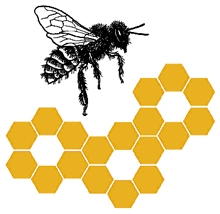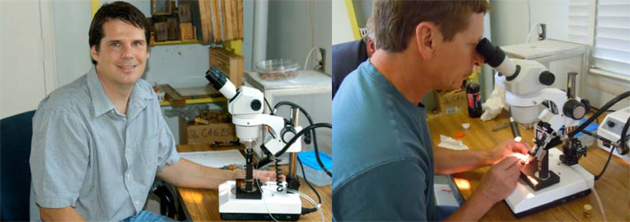
A National Research and Extension Initiative to Reverse Pollinator Decline
This is part of an ongoing series of updates from the Managed Pollinator CAP. Additional installments can be found at the:
More information about the CAP can be found at:
by Greg Hunt, Dave Shenefield, Krispn Given, and Jennifer Tsuruda
CAP Updates: 21
- Jointly published in the American Bee Journal and in Bee Culture, November 2011.
According to the most recent surveys in North America and Europe, Varroa mites still appear to be public enemy #1 for bees, at least among the factors that were measured (Currie et al. 2010; Dahle 2010; Guzmán-Novoa et al. 2010; Peterson et al. 2010). Varroa mites transmit viruses to bees and also can suppress the bee immune system, causing latent viral infections to amplify which results in parasitic mite syndrome. Viruses can also be transmitted in the absence of mites and can often be detected in bees that appear perfectly healthy. Deformed Wing Virus (DWV) is a very common virus associated with mites and colony decline. Most of our colonies at Purdue already have DWV that we can detect by molecular tests, but the bees appear fine. As part of the Purdue University effort for the honey bee health CAP, Jennifer conducted experiments to try to select for bees that are resistant to Israeli Acute Paralysis Virus (IAPV). She inoculated bees with IAPV in cages through feeding. IAPV is one of the viruses transmitted by Varroa and has been associated with rapid colony declines. A sample of mostly IAPV obtained from the Purdue University Bee Lab was mixed with sugar syrup and fed to bees. IAPV has a dramatic effect on the life expectancy of bees in cages.
Bees from many of our colonies were tested by emerging brood in an incubator, marking the bees with paint to distinguish the hive they came from, and keeping them together in cages to be fed sugar syrup, or sugar syrup + IAPV. The sugar syrup contained MegaBee protein supplement for the first 3 days. When the bees were 3 days old, half of the cages got virus in their sugar water. Last fall after these tests, we selected hives that looked relatively susceptible and others that looked more resistant and used instrumental insemination to cross a susceptible hive to another susceptible hive, and also resistants to resistants. This spring, the progeny of these crosses were tested and after averaging three different sets of tests, the resistant cross bees did live a little longer than the susceptibles (Figure 1). But we are discouraged that we did not make more progress and have not repeated these laborious tests. This line of research has multiple problems for us. The biggest one is that our hives have varying levels of mites and viruses to begin with and even newly emerged bees often have virus. Another problem is that our inoculum contained not only IAPV, but detectable levels of DWV. Each type of virus can also have different genetic variants that appear in certain regions of the country. Perhaps we should let natural selection help us to get virus resistant bees by just breeding from the healthiest survivors within a geographic region.

Figure1. Left: IAPV kills bees. Bees kept in cages and fed plain sugar syrup (red line) survived longer than bees fed sugar syrup plus IAPV (blue). Right: After inoculating bees with IAPV in sugar syrup, bees from two hives established from crosses between susceptible sources (green and blue) died faster than bees from the resistant x resistant cross (red).
Breeding for resistance to Varroa.
In North America, some bees are fighting back against mites. Two traits in honey bees have been shown to reduce mite populations. Some bees are good at removing mites from brood, and some are good at removing mites from adult bees. The first trait, Varroa sensitive hygienic behavior or VSH, involves bees removing or uncapping sealed brood that is infested with mites. The USDA Baton Rouge Bee Lab has developed the VSH stock and it has been made available commercially. The other trait is grooming behavior – we are working on increasing the mite-biting behavior in our bees. We developed a lab assay to sample bees from hives and determine how many mites they remove from themselves in three days (Andino and Hunt 2011). We showed that these results correlate with the proportion of chewed mites that fall on a sticky board placed on the bottom board, so both methods can be used to measure grooming behavior. The results also showed that mite-biters had fewer mites on the adult bees. We are using the proportion of chewed mites as our selection tool and breeding from colonies that have higher proportions of chewed mites (see Figure 3). Anyone can do this as long as they have something to magnify the mites about 15X. Usually only legs are missing from the mites. We began in 2007 by looking at just 22 of our hives and found an average of 3% chewed mites on the sticky boards. The highest proportion bitten was 8% . We raised queens from this hive. We have been continuing the selection and have made crosses by instrumental insemination between the best mite-biters. This year we looked at 65 of our colonies and they had an average of 15% chewed mites and many colonies had over 40%, a five-fold increase in grooming behavior! We would like to expand our selection to colonies among commercial operations in Indiana to have a bigger population to select from. Crossing mite-biters with VSH breeders should increase mite resistance even further.

Figure 2. Rarely do we see bites to the body of the mite, but missing legs are common. By counting the damaged mites and dividing by the total number of mites, you can get a measure of the level of grooming activity in a hive.
Encouraging “microbreeders”.
We think it is important that some of the more experienced beekeepers learn how to raise their own queens and do their own selection. The more people doing this, the better we will be able to breed bees that are adapted to local conditions and are resistant to mites, and more breeders means more diversity in our bee population. This year, Dave got a grant through the Indiana Department of Agriculture to increase our ability to raise and distribute queens – an Indiana queen project, similar to what are neighbors in Ohio and Illinois have done. We have had a rocky start this year, but it is a start! The biggest problem was the cold rainy spring weather, which did not allow us to raise many queens until June. But Dave went to a number of local beekeeping associations to get them organized, so that if a number of beekeepers wanted breeding stock from the program the club could send one person to go get queen cells or queens. A part of the cost goes back into the program for next year. We were able to distribute about 300 cells and a few breeder queens, far fewer than our goal of 1,500 cells, but the important thing is that we are set up and ready for next year.

Figure 3. Krispn Given (left) and Dave Shenefield (right) practice instrumental insemination at the Purdue Bee Lab.
For the past three years, members of the honey bee health CAP have been conducting queen-rearing shortcourses. We had two of these in Indiana this year at the Heartland Apiculture Society conference, thanks to Larry Connor, Krispn Given, John Skinner and Mike Wilson. The theme of the HAS conference was “helping bees to help themselves: breeding healthy bees”. There were also demonstrations on how to test bees for hygienic behavior and mite-biting behavior. Joe Latshaw gave an instrumental insemination (I.I.) demonstration. Later in the season, Krispn conducted an I.I. class at Purdue for a few participants in the queen project. We are excited about what seems to be new interest in breeding in the Midwest and are looking forward to next year!
References
Andino GK, Hunt GJ 2011. A scientific note on a new assay to measure honeybee mite-grooming behavior. Apidologie 42:481-484.
Currie RW, Pernal SF, Guzmán-Novoa E 2010. Honey bee colony losses in Canada. J. Apic. Res. 49:104-106.
Dahle, B 2010. The role of Varroa destructor for honey bee colony losses in Norway. J. Apic. Res. 49:124-125.
Guzmán-Novoa E, Eccles L, Calvete Y, McGowan J, Kelly PG, Correa-Benítez A 2010. Varroa destructor is the main culprit for the death and reduced populations of overwintered honey bee (Apis mellifera) colonies in Ontario, Canada. Apidologie
Peterson M, Gray A, Teale A 2010. Colony losses in Scotland in 2004-2006 from a sample survey. J. Apic. Res. 48:145-146.
